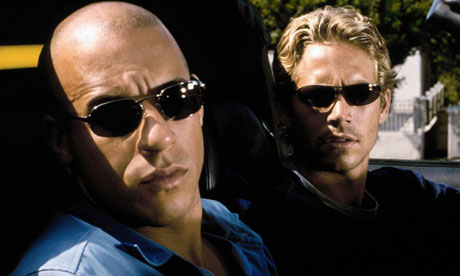How Fast & Furious 6 crushes Iron Man 3
By Armond White
The cynicism that makes Iron Man 3 so lousy is defied by the good-time camaraderie of Fast & Furious 6. Dominic Toretto and Brian O’Connor (Vin Diesel and Paul Walker) are more likable than Robert Downey’s snarky Tony Stark and their friendship makes for greater drama and comedy than Stark’s joshing white/black relationship with Rhodes (Don Cheadle). What’s even finer is Fast & Furious 6’s sense of solidarity; Dom and O’Connor’s criminal-and-cop alliance avoids the Iron Man franchise’s juvenile brand of excitement (that shrill blend of exaggerated violence and superheroism) to provide truly heroic lessons in skill, courage, unity—and speed.
 Both films use previously established characters and rituals to explicate 2013’s post-9/11 malaise (it’s remarkable how the low pleasures of mere genre movies can answer the disappointment of a high-serious thriller like Zero Dark Thirty). But where Iron Man 3 offends lingering fear and doubt and misrepresents the commonweal, Fast & Furious 6 with its gang of outlaws (including Sung Kang, Gal Gadot, Tyrese Gibson, Ludacris, Michelle Rodriguez) joining federal agent Hobbs (Dwayne Johnson) to capture a terrorist offers a metaphor for recognizable community mobilization. And its primary vehicle is that all-American invention the automobile, that tool of transport that ideally represents cinematic innovation and thrall.
Both films use previously established characters and rituals to explicate 2013’s post-9/11 malaise (it’s remarkable how the low pleasures of mere genre movies can answer the disappointment of a high-serious thriller like Zero Dark Thirty). But where Iron Man 3 offends lingering fear and doubt and misrepresents the commonweal, Fast & Furious 6 with its gang of outlaws (including Sung Kang, Gal Gadot, Tyrese Gibson, Ludacris, Michelle Rodriguez) joining federal agent Hobbs (Dwayne Johnson) to capture a terrorist offers a metaphor for recognizable community mobilization. And its primary vehicle is that all-American invention the automobile, that tool of transport that ideally represents cinematic innovation and thrall.
The Iron Man movies cannot overcome their essential cartoonishness. They count on inherited comic book fans but the Fast and Furious franchise’s origin in kinetic filmmaking (the first film’s beautiful nighttime chase scenes with neon-lit undercarriages have not been surpassed) provide a more realistic, richer thrill. Fast & Furious 6 never resorts to Iron Man 3’s pessimistic but basically meaningless conceit “We create our own demons.” Such comic-book derived sarcasm insults post-9/11 history.
That fake Bin Laden figure in Iron Man 3 (played by Ben Kingsley at his most amusing) favors a dubious political position on the war on terror–trivializing it–while also exploiting it. Yet Fast & Furious 6’s Julian Assange-like villain Ian Shaw (played with suave ruthlessness by Jason Statham) updates and upgrades the post-9/11 moral quandary. In fact, Shaw’s threat is uncannily similar to Iron Man 3’s specious promise. Tony Stark’s billionaire intrepidness (like Batman’s) replaces a democratic ideal with aristocracy. (No wonder critics who hated the colorful class satire in Pain & Gain preferred Iron Man 3’s mediocre, class-denying sarcasm.) In this way Iron Man 3 turns patriotism into elitism–as in the scene where the empty-shirt President of the United States hangs in crucifix effigy wearing an Iron Man suit.
Fast & Furious 6 restores democracy to the people. Its working-class cast of heroes represents ethnic street variety–from Diesel’s bi-racial virility and Walker’s blonde/blue virility to their multi-culti male and female comrades. This accounts for the series’ ongoing popularity. Its can-do concept of heroism (“Show me how you drive, I show you who you are,” says Dom) beats superhero projection. The series has progressed from being an underground noir expressing urban conflicts to confronting international crisis–but in a homie’s way.
When Gadot (as one of Dom and O’Connor’s expert driver-martial artists) boasts “This is what we do!” she improves on President Obama’s expedient “That’s not who we are.” Her assertion defines both the gang’s skills and loyalty. Dom puts a fine point on it: “It’s all about family.” His implicit soldierly commitment (patriotism) gives the film significance beyond its genre. In a central role, Rodriguez plays her scenes truculently, dulling the effect of a loved one who loses memory yet bonds through instinct. But in this kind of movie, action is character (as Walter Hill said) and director Justin Lin moves quickly between each character’s motor-driven set-piece. Lin has achieved greater action skills, especially in the airplane/cars chase sequence juggling several climaxes at once. Too darkly lit, it should have been major and revelatory like the multivalent action scenes in Paul W.S. Anderson’s Death Race or Spielberg’s The Adventures of Tintin; instead it suffices as metaphor for democracy rallying against jumbo jet peril.
In Iron Man 3 the terrorist-villain maliciously teases “America, ready for another lesson?” That adolescent taunt conveys historical cynicism in the guise of entertainment; director Shane Black implies that America craves images of its own destruction, which, alas, box-office results suggest might be true. Fast & Furious 6 revels in action but it relishes feeling. Just like the Jesus piece Dom carries, a comrade who is lost-in-battle adds depth and historical resonance to this film’s creation of heroes, not demons. Not malicious in his 9/11 reference, Dom/Diesel in the slowed-down final scene prays “Bless our table.”
Follow Armond White on Twitter at 3xchair
